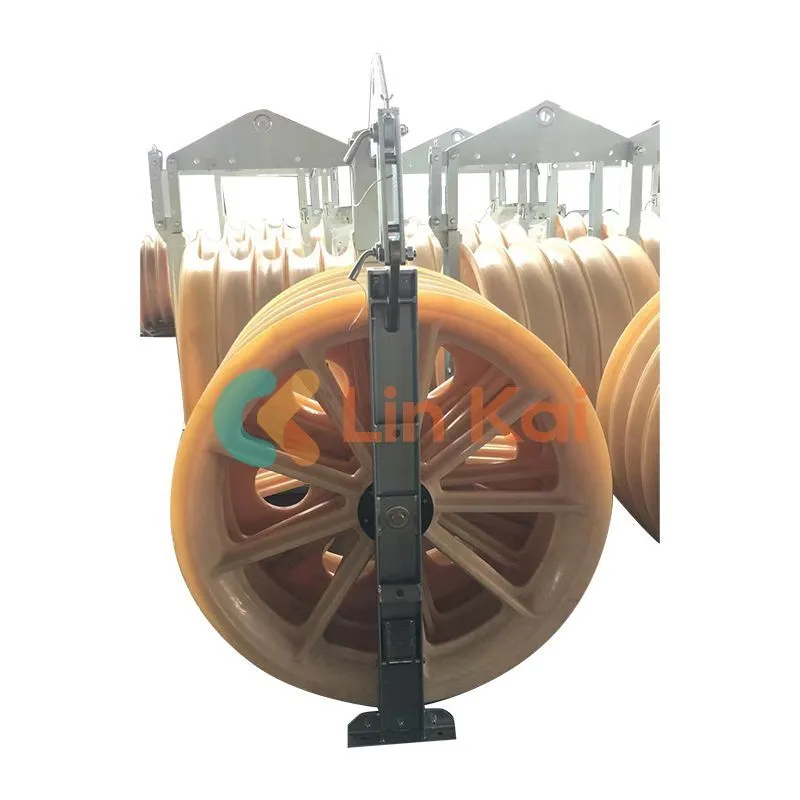What are the benefits of using swivel-mounted Stringing Blocks?
2024-12-10
Benefits of Using Swivel-Mounted Stringing Blocks
Swivel-mounted stringing blocks offer a significant advantage in the installation of high-tension cables for overhead transmission and distribution lines. These blocks are designed to rotate around a central axis, allowing the block to adjust to the movement of the cable as it is pulled during the stringing process. Below are the key benefits of using swivel-mounted stringing blocks:

1. Enhanced Maneuverability and Flexibility
- Adaptability to Cable Path: Swivel-mounted blocks can rotate freely, enabling them to align with the direction of the cable as it is pulled. This allows the cable to follow a smooth, straight path without twisting or kinking, especially when dealing with difficult terrain or complex cable routing.
- Efficient Cable Handling: When cables are pulled through multiple stringing blocks along a route, the ability of each block to swivel reduces friction and minimizes the risk of the cable getting caught or tangled. This makes the overall stringing process more efficient.
2. Reduced Stress on Cables
- Minimized Twisting: Without swivel functionality, cables may twist or rotate as they are pulled through fixed-position blocks. Swivel-mounted blocks prevent this by allowing the block to rotate with the cable, ensuring the cable remains untwisted and maintains its integrity.
- Even Tension Distribution: As the block swivels, it can better distribute the load and tension across the cable, reducing the risk of uneven stretching or damage to the cable fibers. This ensures that high-tension cables are installed without any undue stress, extending the life of the cable and improving the final installation quality.
3. Improved Safety During Installation
- Reduced Risk of Cable Damage: With the freedom of movement that a swivel-mounted block provides, there is less chance of the cable snagging or becoming misaligned during the installation process. This reduces the likelihood of cable damage, which is critical for preventing costly delays and ensuring a safe installation.
- Safety for Workers: By ensuring the cable follows a smooth and controlled path, swivel-mounted blocks help minimize sudden jerks or shifts in the cable, lowering the risk of accidents or injuries to workers involved in the stringing process.
4. Better Performance in Complex Terrain
- Easier Navigation of Angles and Corners: Overhead transmission lines often need to follow difficult, uneven, or sloped terrain, with sharp turns or angles. Swivel-mounted stringing blocks can navigate these complex routes by swiveling to accommodate changes in direction, allowing for a more efficient stringing process without additional manual adjustments.
- Enhanced Control in Harsh Conditions: Swivel-mounted blocks provide greater control over the cable as it is being strung, especially in challenging environmental conditions such as windy or stormy weather, where the cable is more prone to swinging or misalignment.
5. Increased Durability and Longevity
- Reduced Wear and Tear: The swivel mechanism reduces the friction that would otherwise be experienced if the block remained stationary. This results in less wear on both the block and the cable, extending the lifespan of both components. The ability to pivot freely also prevents the block from becoming damaged by being forced into unnatural positions.
- Long-Term Cost Savings: Because swivel-mounted blocks can better handle the rigors of heavy-duty use without the need for constant repositioning or repairs, they often result in lower maintenance costs over time, which is especially beneficial for large-scale installations.
6. Faster Installation Process
- Faster Cable Pulling: The reduced friction and improved alignment provided by swivel-mounted blocks make the process of pulling the cable faster and smoother. The blocks’ ability to adjust as the cable is pulled through significantly reduces the effort required by the installation team, leading to a more streamlined and efficient operation.
- Fewer Adjustments Needed: Since the swivel function allows the blocks to move with the cable, fewer adjustments are required during the stringing process. This minimizes downtime and helps the project stay on schedule.
7. Versatility for Different Cable Types and Sizes
- Adaptability to Various Cable Sizes: Swivel-mounted stringing blocks are often designed to accommodate different types of cables, including large, high-tension cables or multi-conductor cables. Their ability to pivot and adjust makes them ideal for a variety of cable sizes and installations, making them versatile tools in the stringing process.
- Compatibility with Multiple Stringing Blocks: These blocks are compatible with other stringing equipment and can be used in tandem with cable pullers, tensioners, and other accessories. This makes them adaptable to a range of transmission line projects.
Conclusion
Swivel-mounted stringing blocks are a valuable tool in high-tension cable installations, providing improved maneuverability, reduced risk of cable damage, and enhanced safety. Their ability to pivot with the cable as it is pulled allows for smoother, more efficient installations, especially in complex terrains or challenging conditions. Additionally, their durability, versatility, and potential for speeding up the stringing process make them an essential component in modern cable installation projects.


